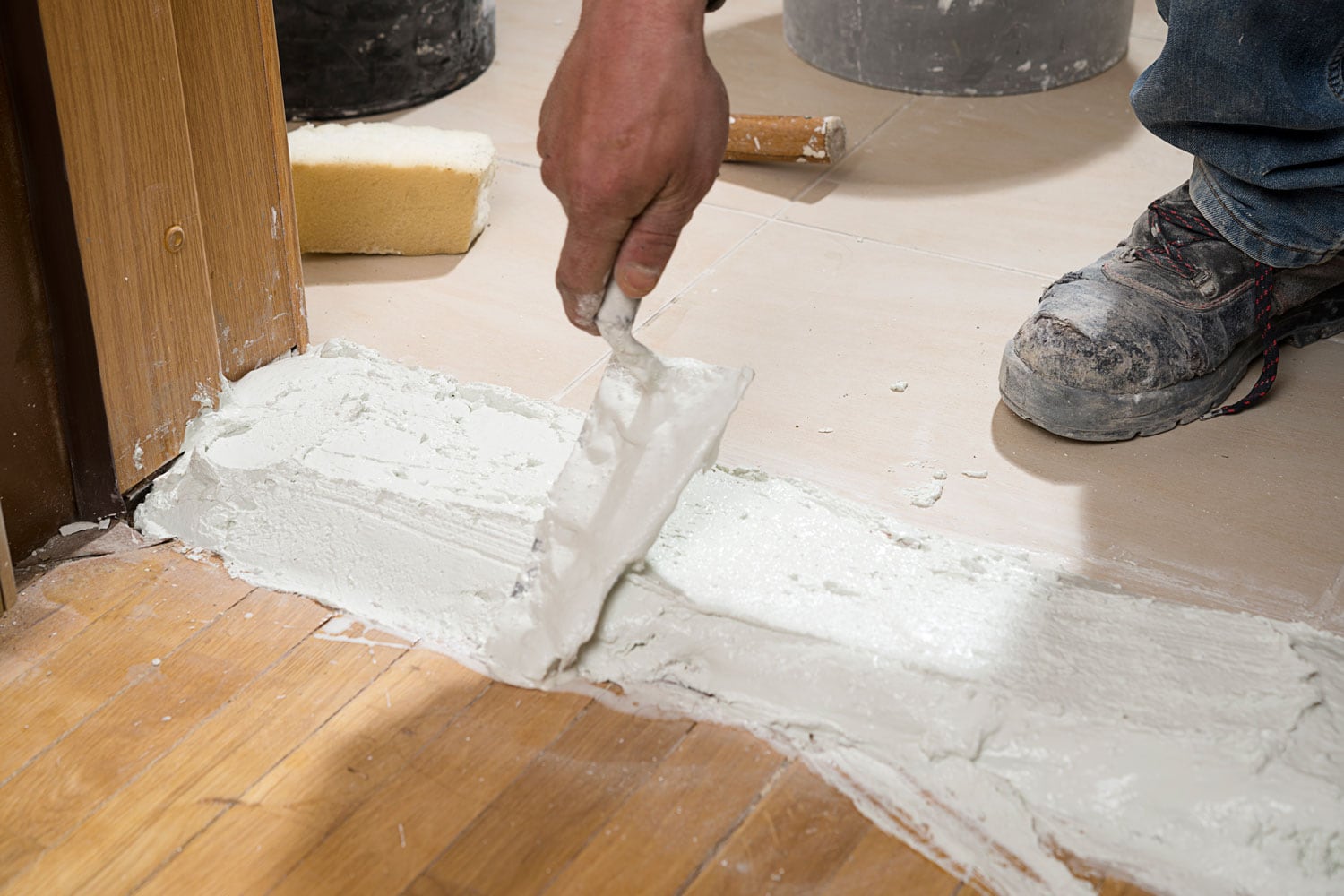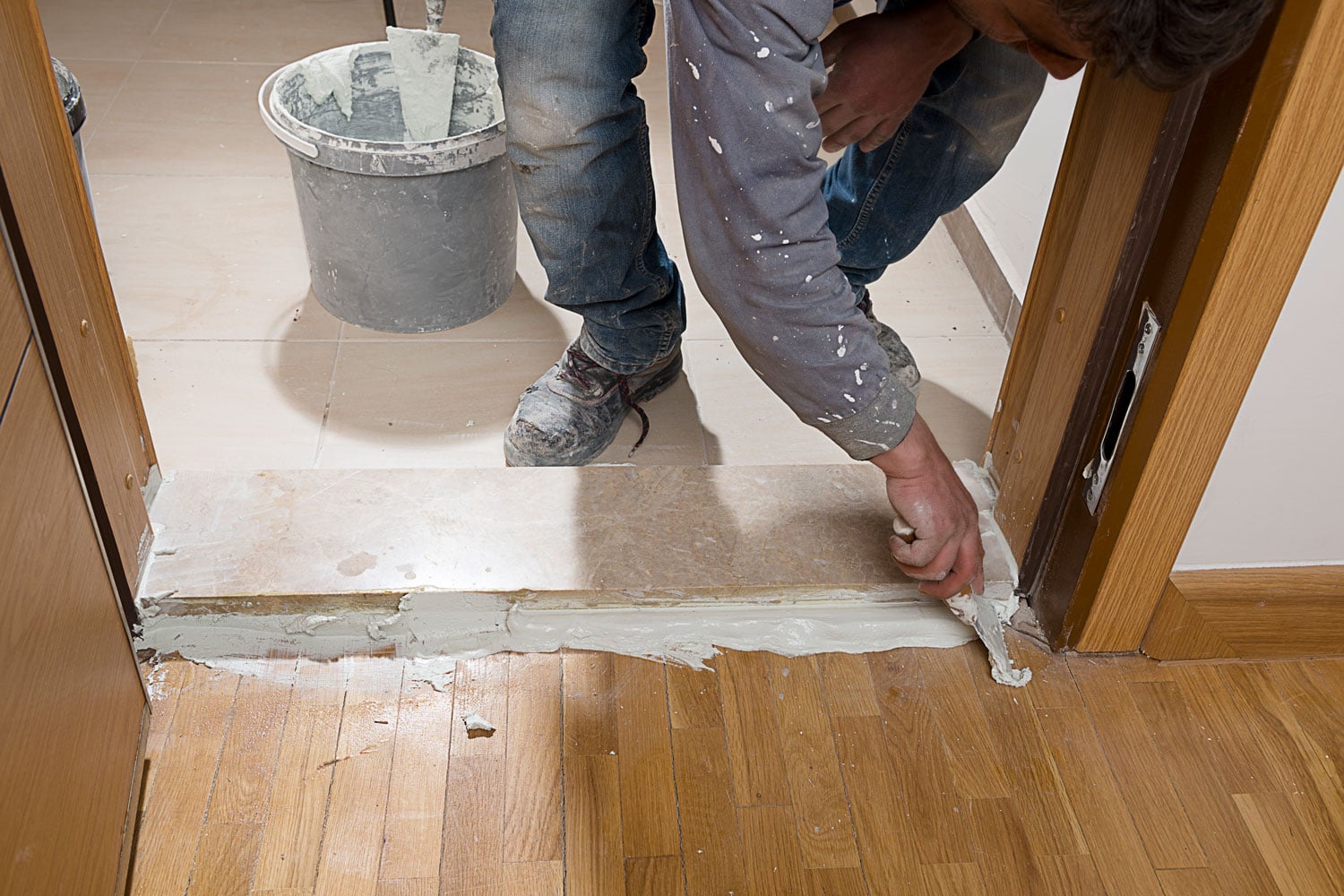Making sure your doorways are adequately sealed and weatherproofed can make a difference in your energy bills, air quality, and overall cleanliness. You may be wondering how you can properly seal a door threshold to concrete. We have thoroughly investigated and have found some ways you can effectively seal over concrete.
To properly seal your door threshold to concrete, you can either use a liquid seal around an existing threshold or install a weatherproof rubber seal. The steps are similar for both processes.
- Examine the threshold area
- Choose an appropriate seal for the threshold
- Repair gaps and cracks
- Make sure the existing threshold is secure
- Clean the threshold area
- Apply a weatherproof liquid or rubber seal
- Allow seal or adhesive to dry properly
Sealing your door threshold may seem like a complicated process, but we'll break down the steps for you and discuss different methods for sealing under a threshold. Keep reading as we cover reasons you would need to seal a door threshold and how you can weatherproof your garage or basement doorway.

1. Examine The Threshold Area
Before you know which route you will take in sealing the door threshold, you will want to thoroughly inspect the area where you will be applying the seal. Measure the area you are sealing and decide what type of material to use.

Look for bumps and uneven cement to see if you'll need a grinder, and check for gaps and cracks to see if you'll need to repair them before applying a seal. Finally, if there is an existing threshold, make sure it's in good condition and not loose. You want it to last the life of your seal.
2. Choose An Appropriate Seal For The Threshold
There are a few different types of seals you can apply depending on the reason and size of space you are sealing. For sealing around a door threshold with a metal or wooden plate, if it's a tight fit, you can use a waterproof sealer like this concrete and mortar filler that also functions as a sealant.
Click here to see this waterproof filler on Amazon.
Should You Caulk Under A Door Threshold?
For small thin gaps where appearance is a concern, a popular choice is using a silicone-based caulk that dries clear. This Gorilla caulk and seal is suitable for all-weather and dries in 30 minutes. Easy to use, it comes in clear and white.
Click here to see this waterproof caulk and seal on Amazon.
Can You Use Expanding Foam Under The Door Threshold?
For larger gaps, you may choose an expanding foam. Choose a foam that is suited for doorway thresholds. It should be a minimal expanding foam as regular foam can cause the threshold to lift over time, causing problems with doors sticking or not closing properly. Some experts will use expanding foam together with a silicone seal.
Click here to see a minimal expanding foam for doorways on Amazon.
3. Repair Gaps And Cracks
After examining the area for gaps and cracks and choosing your materials, make the necessary repairs before applying the sealant. Fill in gaps and cracks with construction putty or liquid cement and allow to dry. Sand or grind the area until smooth.
Click here to see a concrete filler on Amazon.
4. Make Sure The Existing Threshold Is Properly Fastened
Before you apply or install your seal, make sure it is secure if there is an existing threshold. A loose threshold will cause the seal to weaken in a short time, and you will soon need to repeat the process. If required, replace screws or apply an adhesive to secure the threshold to the concrete.
How Do You Secure A Door Threshold To Concrete?
Many thresholds on concrete may have been improperly installed. Experts agree that the best practice is to use Tapcon flathead screws to secure a door threshold. Avoid using extra-long screws as they may break. These Tapcon concrete screws come with their own drill bit.
Click here to see these screws for concrete on Amazon.
5. Clean The Threshold Area
After repairs have been made and the threshold is fastened, clean the area of any debris. Loose dust may make your seal ineffective and brittle.
6. Apply A Weatherproof Liquid Or Rubber Seal
Once the area is clean and dry, you can apply your seal. If working with an existing threshold, apply in one smooth movement along the underside of the threshold and concrete. Make sure the applicator tip stays inside the gap and use the edge of the threshold as a guide to keeping your line straight. Remove any excess sealer.
This DIY Youtuber gives you tips on applying a liquid concrete sealer to a concrete threshold.
For more on sealing and securing a threshold for an exterior doorway, read our article "How To Seal An Exterior Door Threshold."
How To Install A Rubber Seal For A Garage Door

If you want to weatherproof a garage threshold, the process may vary slightly. Many homeowners choose to go with a rubber threshold seal. These seals can be used instead of or together with a silicone-based caulk. If you get a kit, it will come with its own adhesive made for adhering the rubber seal to concrete.
Click here to see Weather Defender rubber seal on Amazon.
To install, once you have examined and measured the area and cleaned it, cut your weatherstrip and apply the adhesive, then press it to the concrete. A product like Liquid Nails or epoxy is usually used to secure the seal if your kit does not come with adhesive.
Click here to see Liquid Nails on Amazon.
The following video shows how one homeowner fixed his leaky garage door using a rubber seal. He demonstrates how to prepare your area and how he modified the corners to allow the water to drain to the exterior keeping it out of the garage.
7. Allow Seal Or Adhesive To Dry Properly
Schedule your project at a low traffic time. If you are sealing a doorway with a transition, the seal will usually need 30 minutes to an hour to dry. A rubber seal adhesive may take as long as 24 to 48 hours to set completely.
Why Should You Seal A Door Threshold?
It may seem like more work than it's worth, but maintaining a proper seal on your door threshold is essential. Not only does it keep damage caused by moisture at bay, but an effective seal can keep out pests and help save on energy bills by reducing thermal transfer.
Can You Use A Door Sweep Over Concrete?

On some doorways, a rubber seal or a brush is affixed to the bottom of the door. You may be able to use a high-quality brush door sweep over concrete since they are versatile and will not be worn down by the rough surface. This type is suitable for interior doors and will keep out debris.
A door sweep is not an effective solution for sealing exterior doors over concrete since weatherproofing and deterring insects would require a rubber or neoprene sweep.
This type of sweep would wear down quickly over cement. If you are sealing a threshold on an exterior doorway, use a weather strip or fixed seal to the floor for maximum effectiveness.
Final Thoughts

Now that you know how to seal a door threshold to concrete and lay down a rubber seal on a concrete floor, begin to prepare for your project. Plan to complete your work on a day where you can control foot traffic. You'll want to plan for a sunny day to give your seal a chance to dry before it's tested by the weather for the best result!
Want to read more about weatherproofing your home? Check these articles out.







